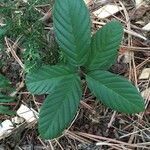Large shrub or small tree (2)-6-7 m tall. Buds, young shoots and very young lvs with ferruginous tomentum. Petiole 1-2.5 cm long, tomentose. Lamina 5-13.5 × 3-7 cm, broad-elliptic or elliptic-obovate, ± hairy, densely hairy on the raised 12-16 pairs of veins beneath, subentire or crenulate-serrulate; base rounded or subcordate; apex mostly shortly cuspidate. Peduncles 5-35 mm long, ferruginous-tomentose; pedicels similar but shorter. Bracts to 1 mm long, subulate. Calyx c. 4 mm long, ferruginous-tomentose outside; lobes 1.3-2 mm long, triangular. Petals included, whitish; < calyx lobes; limb wider than long. Style c. 1 mm long; ovary glabrous. Fr. turbinate, black, 3-seeded.
A very small tree. It grows to about 6 m high. The trunk can be 25 cm across. The bark is thin and greyish-brown. The leaves are alternate and simple. They are 4-16 cm long and usually widest just above the middle. The base is rounded and the tip is short. There are fine teeth along the edge. The flowers are yellowish green. They are small. The fruit are like berries. They are round and blackish. They are 8-14 mm across and contain 2-3 small nutlike seeds.


